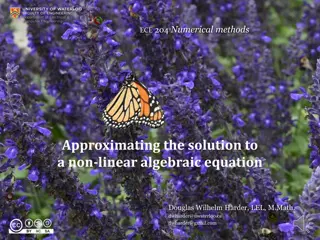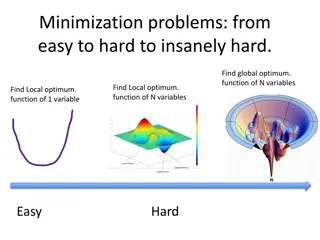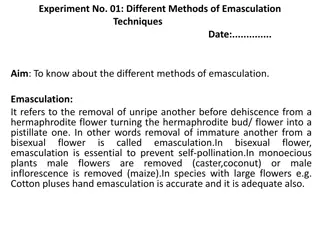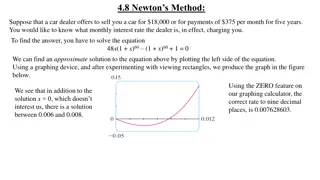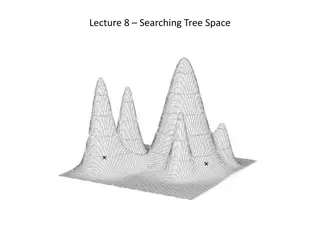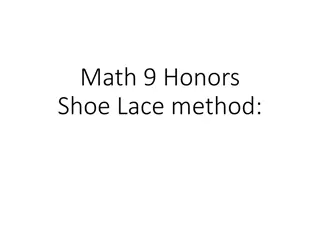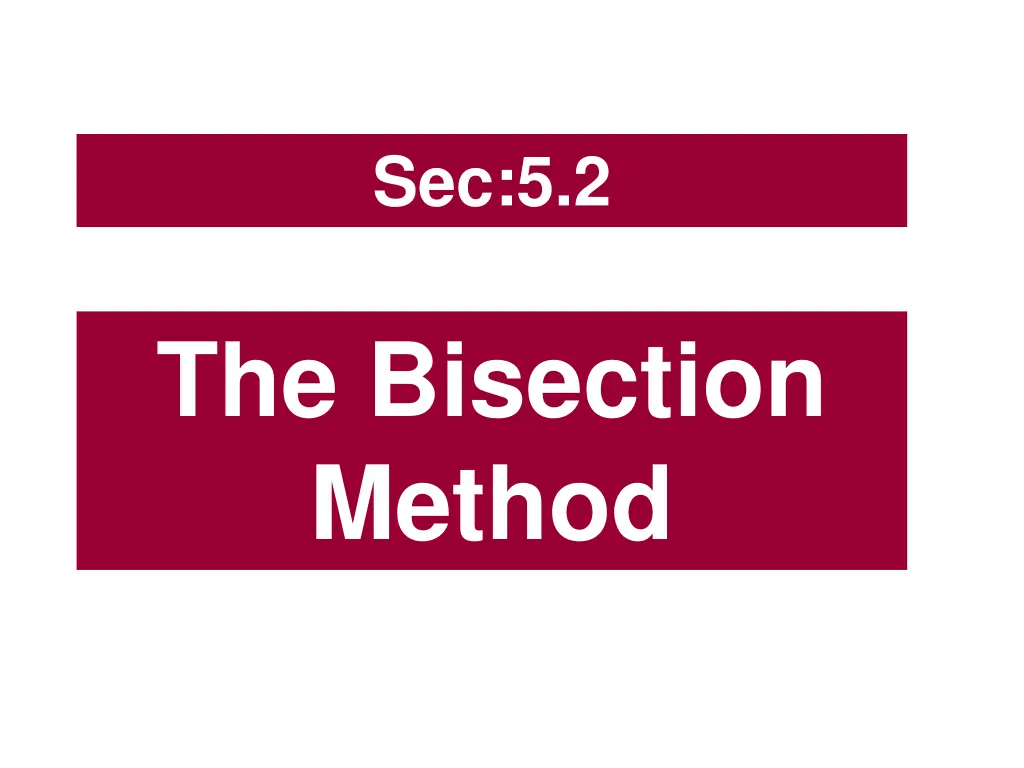
Bisection Method for Root Finding
Learn about the Bisection Method for root finding in mathematics, a technique based on the Intermediate Value Theorem. Discover how to find roots of functions using this method and understand the process with examples and error estimates.
Download Presentation

Please find below an Image/Link to download the presentation.
The content on the website is provided AS IS for your information and personal use only. It may not be sold, licensed, or shared on other websites without obtaining consent from the author. If you encounter any issues during the download, it is possible that the publisher has removed the file from their server.
You are allowed to download the files provided on this website for personal or commercial use, subject to the condition that they are used lawfully. All files are the property of their respective owners.
The content on the website is provided AS IS for your information and personal use only. It may not be sold, licensed, or shared on other websites without obtaining consent from the author.
E N D
Presentation Transcript
Sec:5.2 The Bisection Method
Sec:5.2 The Bisection Method The root-finding problem is a process involves finding a root, or solution, of an equation of the form ? ? = 0 for a given function ? . A root of this equation is also called a zero of the function ? . In graph, the root (or zero) of a function is the x-intercept three numerical methods for root-finding Sec(2.1): The Bisection Method root Sec(2.2): Fixed point iterations Sec(2.3): The Newton-Raphson Method
Sec:5.2 The Bisection Method This technique is based on the Intermediate Value Theorem Example: Suppose ? is a continuous function defined on the interval [?,?], with ? (?) and ? (?) of opposite sign. The Intermediate Value Theorem implies that a number ? exists in (?,?) with ? ( ?) = 0. Show that 10?6 149?5+ 10? 149 10(?4+ 1) ? (?) = has a root in [12, 16] Sol: 12 16 ?(??) = ??.? ?(??) = ??.?
Sec:5.2 The Bisection Method Example: Use Bisection method to find the root of the function 12 16 Change of sign 17.6 -34.8 10?6 149?5+ 10? 149 10(?4+ 1) ? (?) = ?? = 14 in [12, 16] True root: ?? = 14.9 12 16 Change of sign ?? ? -12.6 -34.8 17.6 1 14.0000000000 2 15.0000000000 3 14.5000000000 4 14.7500000000 5 14.8750000000 6 14.9375000000 7 14.9062500000 8 14.8906250000 9 14.8984375000 10 14.9023437500 11 14.9003906250 12 14.8994140625 13 14.8999023438 14 14.9001464844 15 14.9000244141 16 14.8999633789 ?? = 16 14 15 Change of sign -12.6 1.5 17.6 ?? = Change of sign 14.5 15 14 1.5
Sec:5.2 The Bisection Method ? = ?? ? = ?? Textbook notations 12 16 Change of sign Iter1 ?? 17.6 -34.8 At the n-th iteration: endpoints of the inteval ?? ?? 12 14 16 Change of sign [ ??,??] Iter2 ?? -12.6 -34.8 17.6 Length of the interval ?? ?? 16 14 15 ?? ??= Change of sign ?? Iter3 -12.6 1.5 17.6 ??=? ? ?? ? ?? ?? Change of sign 14.5 15 14 Iter4 1.5 ??
Sec:5.2 The Bisection Method ?? Error Estimates for Bisection ?? 12 14 16 Iter1 -12.6 ?? -34.8 17.6 ????? = ?? ? At the iter1: ? ?( (length of the interval) ?? ? ? length of the interval) True root live inside this interval <? ? ?? ? ? At the iter2: ?? ? ?? ?? 16 14 15 ? ?( (length of the interval) length of the interval) Iter2 ? ? ?? ?? ? -12.6 1.5 ?? 17.6 Theorem 2.1 Suppose that f C[a, b] and f (a) generates a sequence ?? approximating a zero p of f with ? ? ?? At the nth iteration: f (b) < 0. The Bisection method ? ?( (length of the interval) ?? ? length of the interval) the absolute error in the n-th iteration ? ? ?? ?? ? ? ? ?? ?? ?
Sec:5.2 The Bisection Method Example: Theorem 2.1 Show that Suppose that f C[a, b] and f (a) Bisection method generates a sequence ?? approximating a zero p of f with f (b) < 0. The 10?6 149?5+ 10? 149 10(?4+ 1) ? (?) = ? ? ?? ?? ? has a root in [12, 16] Remark ?? ?? ? ? It is important to realize that Theorem 2.1 gives only a bound for approximation error and that this bound might be quite conservative. For example, 1 14.0000 9.0000e-01 2 15.0000 1.0000e-01 3 14.5000 4.0000e-01 4 14.7500 1.5000e-01 5 14.8750 2.5000e-02 6 14.9375 3.7500e-02 7 14.9063 6.2500e-03 8 14.8906 9.3750e-03 9 14.8984 1.5625e-03 ?7 ? <16 12 = 3.125? 2 27 ?7 ? = 6.25? 3
Sec:5.2 The Bisection Method Theorem 2.1 Example: Suppose that f C[a, b] and f (a) Bisection method generates a sequence ?? approximating a zero p of f with f (b) < 0. The Show that 10?6 149?5+ 10? 149 10(?4+ 1) ? (?) = ? ? ?? ?? ? has a root in [12, 16] Example Determine the number of iterations necessary to solve f (x) = 0 with accuracy 10 2 using a1 = 12 and b1 = 16. ?? ? <?? ?? ?? ?? ? ?? ? 1 14.0000 9.0000e-01 2 15.0000 1.0000e-01 3 14.5000 4.0000e-01 4 14.7500 1.5000e-01 5 14.8750 2.5000e-02 6 14.9375 3.7500e-02 7 14.9063 6.2500e-03 8 14.8906 9.3750e-03 9 14.8984 1.5625e-03 10 14.9023 2.3437e-03 11 14.9004 3.9062e-04 12 14.8994 5.8594e-04 < ?? ? the desired error ? solve for n: ??> ? > 8.64 ? = 9 ?? ? Remark It is important to keep in mind that the error analysis gives only a bound for the number of iterations. In many cases this bound is much larger than the actual number required.
Sec:5.2 The Bisection Method Theorem 2.1 Rates of Convergence Suppose that f C[a, b] and f (a) Bisection method generates a sequence ?? approximating a zero p of f with f (b) < 0. The sequence: { n} {??} 0 ? ? ?? then we say that { n} converges to with rate of convergence O(??). ?? ? If a positive constant K exists with (? ?)? | n | K ?? for large n, Then we write: ?? ? ?? ?? ?? ? ?? n = + O(??). the sequence ?? rate of convergence O(? converges to p with ??).
Sec:5.2 The Bisection Method %% clear; clc a=12; b=16; es=1e-3; f=@(x) ( x.^5*(10*x-149) + 10*x - 149)./(10*(x^4+1)); %% max_iter= round((log(b-a)-log(es))/log(2)); fa=f(a); fb=f(b); iter =0; if fa*fb > 0,return,end %% for k=1:max_iter iter = iter +1; p=(a+b)/2; fp=f(p); x(k)=p; if fp==0 a=p; b=p; elseif sign(fb)*sign(fp)<0 a=p; fa=fp; else b=p; fb=fp; end fprintf('%d %14.4f %14.4e \n', iter,p,abs(p-14.9)); end Remark sign(fb)*sign(fp)<0 instead of fb*fp<0 avoids the possibility of overflow or underflow in the multiplication




